Philips 288P6LJEB/00 User Manual

288P6
www.philips.com/welcome |
|
EN User manual |
1 |
Customer care and warranty |
37 |
Troubleshooting & FAQs |
43 |
Table of Contents
1. Important ............................................... |
1 |
|
1.1 |
Safety precautions and maintenance .1 |
|
1.2 |
Notational Descriptions ............................ |
2 |
1.3 |
Disposal of product and packing |
|
|
material ............................................................... |
3 |
2. Setting up the monitor ....................... |
4 |
|
2.1 |
Installation ......................................................... |
4 |
2.2 |
Operating the monitor .............................. |
6 |
2.3 |
MultiView .......................................................... |
9 |
2.4 |
Remove the Base Assembly for VESA |
|
|
Mounting ......................................................... |
12 |
|
|
|
|
introduction ................................................. |
13 |
3. Image Optimization ........................... |
14 |
|
3.1 |
SmartImage ................................................... |
14 |
3.2 |
SmartContrast ............................................. |
15 |
3.3 |
Philips SmartControl Premium .......... |
15 |
3.4 |
SmartDesktop Guide ............................. |
22 |
|
..................... |
27 |
|
|
4.1 |
Resolution & Preset Modes ................. |
29 |
5. |
Power Management ........................... |
30 |
|
6. |
Regulatory Information ..................... |
31 |
|
7. |
Customer care and warranty .......... |
37 |
|
|
7.1 |
Philips’ Flat Panel Monitors Pixel |
|
|
|
Defect Policy ................................................. |
37 |
|
7.2 |
Customer Care & Warranty ............... |
39 |
8. |
Troubleshooting & FAQs .................. |
43 |
|
|
8.1 |
Troubleshooting .......................................... |
43 |
|
8.2 |
SmartControl Premium FAQs ........... |
44 |
|
8.3 |
General FAQs .............................................. |
45 |
|
8.4 |
Multiview FAQs .......................................... |
47 |

1. Important
1. Important
This electronic user’s guide is intended for anyone who uses the Philips monitor.Take time to read this user manual before you use your monitor. It contains important information and notes regarding operating your monitor.
The Philips guarantee applies provided the product is handled properly for its intended use, in accordance with its operating instructions and upon presentation of the original invoice or cash receipt, indicating the date of purchase, dealer’s name and model and production number of the product.
1.1Safety precautions and maintenance
 Warnings
Warnings
Use of controls, adjustments or procedures may result in exposure to shock, electrical hazards and/or mechanical hazards.
Read and follow these instructions when connecting and using your computer monitor.
Operation
! Please Keep the monitor out of direct sunlight, very strong bright lights and away from any other heat source. Lengthy exposure to this type of environment may result in discoloration and damage to the monitor.
! Remove any object that could fall into ventilation holes or prevent proper cooling of the monitor’s electronics.
! Do not block the ventilation holes on the cabinet.
! When positioning the monitor, make sure the power plug and outlet are easily accessible.
! If turning off the monitor by detaching the power cable or DC power cord, wait for 6 seconds before attaching the power cable or DC power cord for normal operation.
! Please use approved power cord provided by Philips all the time. If your power cord is missing, please contact with your local service center. (Please refer to Customer " " # $ "
! Do not subject the monitor to severe vibration or high impact conditions during operation.
! Do not knock or drop the monitor during operation or transportation.
Maintenance
! To protect your monitor from possible damage, do not put excessive pressure on the LCD panel.When moving your monitor, grasp the frame to lift; do not lift
the monitor by placing your hand or fingers on the LCD panel.
! Unplug the monitor if you are not going to use it for an extensive period of time.
! Unplug the monitor if you need to clean it with a slightly damp cloth.The screen may be wiped with a dry cloth when the power is off. However, never use organic solvent, such as, alcohol, or ammonia-based liquids to clean your monitor.
! To avoid the risk of shock or permanent damage to the set, do not expose the monitor to dust, rain, water, or excessive moisture environment.
! If your monitor gets wet, wipe it with dry cloth as soon as possible.
! If foreign substance or water gets in your monitor, please turn the power off immediately and disconnect the power cord.Then, remove the foreign substance or water, and send it to the maintenance center.
! Do not store or use the monitor in locations exposed to heat, direct sunlight or extreme cold.
! In order to maintain the best performance of your monitor and use it for a longer lifetime, please use the monitor in a location that falls within the following temperature and humidity ranges.
1

1. Important
! Temperature: 0-40°C 32-95°F
! Humidity: 20-80% RH
Important information for Burn-in/Ghost image
! Always activate a moving screen saver program when you leave your monitor unattended. Always activate a periodic screen refresh application if your monitor will display unchanging static content. Uninterrupted display of still or static images over an extended period may cause “burn in”, also known as “after-imaging” or “ghost imaging”, on your screen.
! “Burn-in”,“after-imaging”, or “ghost imaging” is a well-known phenomenon in LCD panel technology. In most cases, the “burned in” or “after-imaging” or “ghost imaging” will disappear gradually over a period of time after the power has been switched off.
 Warning
Warning
Failure to activate a screen saver, or a periodic screen refresh application may result in severe “burn-in” or “after-image” or “ghost image” symptoms that will not disappear and cannot be repaired.The damage mentioned above is not covered under your warranty.
Service
! The casing cover should be opened only by qualified service personnel.
! If there is any need for any document for repair or integration, please contact with your local service center. (please refer to the chapter of “Consumer Information " '
! For transportation information, please refer to “Technical Specifications”.
! Do not leave your monitor in a car/trunk under direct sun light.
 Note
Note
Consult a service technician if the monitor does not operate normally, or you are not sure what procedure to take when the operating instructions given in this manual have been followed.
1.2 Notational Descriptions
The following subsections describe notational conventions used in this document.
Notes, Cautions and Warnings
Throughout this guide, blocks of text may be accompanied by an icon and printed in bold or italic type.These blocks contain notes, cautions or warnings.They are used as follows:
 Note
Note
This icon indicates important information and tips that help you make better use of your computer system.
 Caution
Caution
This icon indicates information that tells you how to avoid either potential damage to hardware or loss of data.
 Warning
Warning
This icon indicates the potential for bodily harm and tells you how to avoid the problem.
Some warnings may appear in alternate formats and may not be accompanied by an icon. In such) $ * mandated by the relevant regulatory authority.
2

1. Important
1.3Disposal of product and packing material
Waste Electrical and Electronic Equipment-
WEEE
This marking on the product or on its packaging illustrates that, under European Directive 2012/19/EU governing used electrical and electronic appliances, this product may not be disposed of with normal household waste.You are responsible for disposal of
this equipment through a designated waste electrical and electronic equipment collection. To determine the locations for dropping off such waste electrical and electronic, contact + < $ ) * organization that serves your household or the store at which you purchased the product.
Your new monitor contains materials that can be recycled and reused. Specialized companies can recycle your product to increase the amount of reusable materials and to minimize the amount to be disposed of.
All redundant packing material has been omitted.We have done our utmost to make the packaging easily separable into mono materials.
= how to dispose of your old monitor and packing from your sales representative.
Taking back/Recycling Information for Customers
Philips establishes technically and economically viable objectives to optimize the environmental performance of the organization's product, service and activities.
From the planning, design and production stages, Philips emphasizes the important of
making products that can easily be recycled. At Philips, end-of-life management primarily entails participation in national take-back initiatives and recycling programs whenever possible, preferably in cooperation with competitors, which recycle all materials (products and related* Environmental Laws and taking back program with the contractor company.
Your display is manufactured with high quality materials and components which can be recycled and reused.
To learn more about our recycling program please visit
http://www.philips.com/sites/philipsglobal/ about/sustainability/ourenvironment/ productrecyclingservices.page
3
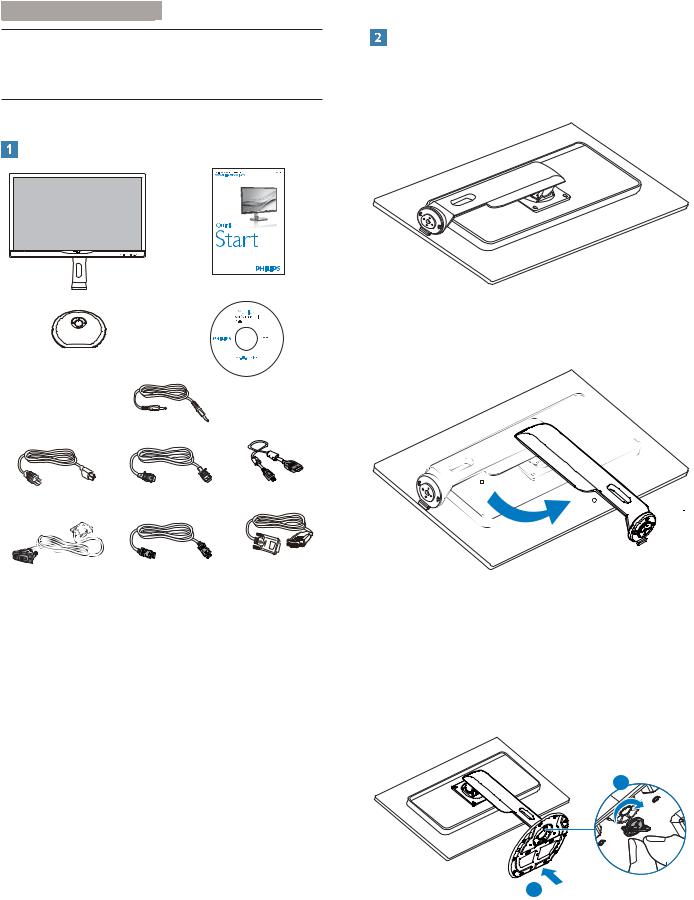
2. Setting up the monitor
2. Setting up the monitor
2.1 Installation
Package contents
288P6LJ
|
|
|
|
© |
|
|
User’s Manual |
2 |
|
|
|
01 |
|
|
Monitor drivers |
4K |
|
||
oni |
|
|
SmartControl software |
nk |
|
|
|
likje |
|
|
|
|
Ph |
|
|
|
ilpi |
|
|
|
sN |
|
|
|
V.. |
|
|
|
All |
|
|
|
rig |
|
|
|
hts |
|
|
|
re |
|
|
|
ser |
|
|
|
ved |
|
|
|
.Un |
|
|
|
auth |
|
|
|
orize |
|
pr |
|
d duplication is a violatio nof |
applicable laws.Madeand |
|
Audio
Power |
HDMI (optional) |
MHL (optional) |
Dual-link DVI (optional) |
DP (optional) |
VGA (optional) |
Install the base
1.Place the monitor face down on a smooth surface. Pay attention not to scratch or damage the screen.
2.Rotate the neck counterclockwise 90 degree.
0
90
3.Use the assembly screw for base to fasten the base securely to the monitor.
? @ +
J + * located at the bottom of the base, and secure the base to the stand tightly.
2
1
4
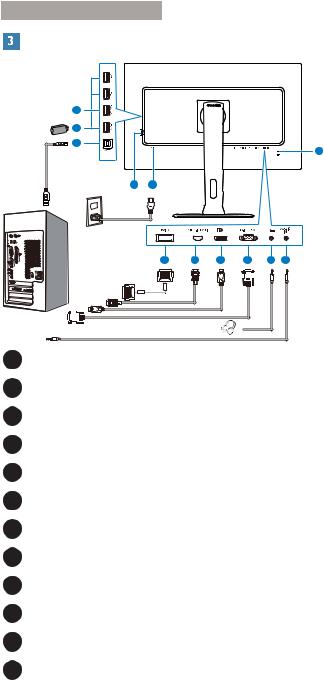
2. Setting up the monitor
Connecting to your PC |
|
Connect to PC |
|
|
|
1. |
Connect the power cord to the back of |
|
|
2. |
+ |
12 |
|
Turn off your computer and unplug its |
|
11 |
|
|
power cable. |
10 |
|
|
|
1 |
|
|
|
|
3. |
Connect the monitor signal cable to the |
|
|
|
||
9 8 |
|
|
video connector on the back of your |
|
|
|
computer. |
|
|
4. |
Plug the power cord of your computer and |
|
|
|
your monitor into a nearby outlet. |
7 |
6 |
5 |
4 |
3 |
2 |
5.Turn on your computer and monitor. If the monitor displays an image, installation is complete.
1 Kensington anti-theft lock
2 Audio input
3 Earphone jack
4 VGA input
5 Display port input
6 MHL-HDMI input
7 DVI input
8 AC power input
9 Power Switch
10USB upstream
11USB port
12USB fast charger
5
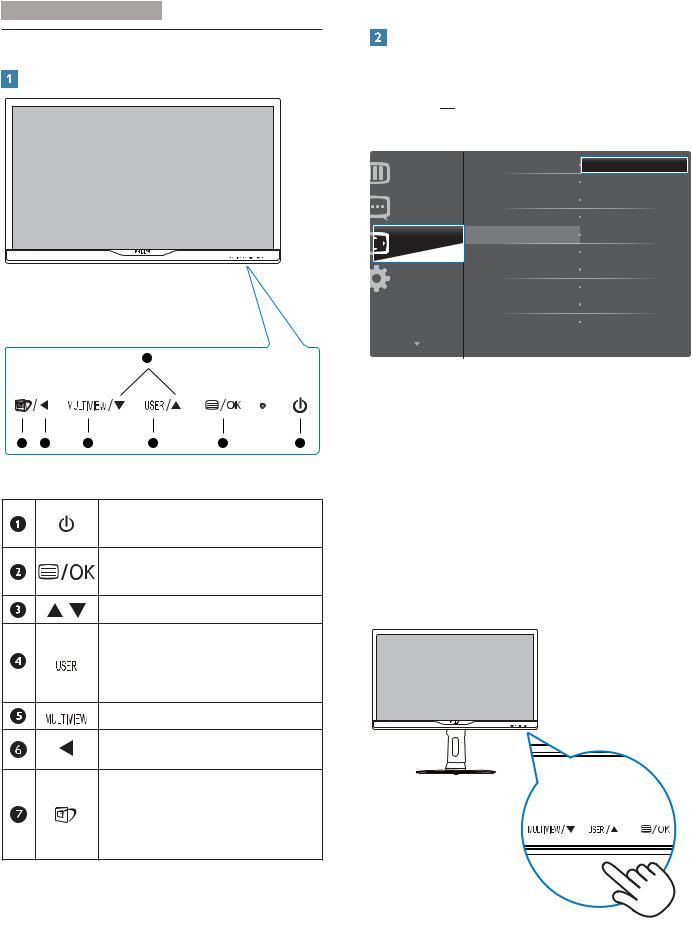
2. Setting up the monitor
2.2 Operating the monitor
Description of the control buttons
3
7 |
6 |
5 |
4 |
2 |
1 |
Switch monitor’s power ON or
OFF.
Access the OSD menu. " XZ [
Adjust the OSD menu.
User preference key. Customize your own preference function from OSD to become the “user key”.
PiP/PbP/Off/Swap
Return to previous OSD level.
SmartImage hot key.There\ ] X$ ) Photo, Movie, Game, Economy, SmartUniformity, Off.
Customize your own “USER” key
This hot key allows you to setup your favorite function key.
1.Press  button on the front bezel to enter OSD Menu Screen.
button on the front bezel to enter OSD Menu Screen.
|
|
|
|
|
|
|
Horizontal |
|
|
|
Audio Source |
||||
|
|
|
|
|
|
|
|
|
|
|
|
|
|
|
|
Color |
|
|
|
|
|
|
|
|
|
||||||
|
|
|
|
|
|
|
|
|
|
|
|
|
|
|
|
|
|
|
|
|
|
Vertical |
Volume |
||||||||
|
|
|
|
|
|
|
|
|
|
|
|
|
|||
|
|
|
|
|
|
Transparency |
Input |
||||||||
|
|
Language |
|
|
|
|
|
|
|
|
|
|
|||
|
|
|
|
|
|
|
OSD Time out |
|
|
|
|
|
|||
|
|
|
|
|
|
User |
|
|
|
|
|||||
OSD Settings |
|
|
|
|
|||||||||||
|
|
|
|
|
|
|
|
|
|
|
|
||||
Setup |
|
|
|
|
|||||||||||
2.= ^ _ [OSD Settings], then press 
 button.
button.
3.= ^ _ |User], then press 
 button.
button.
4.= ^ _ + preferred function: [Audio Source], [Volume], or [Input].
5.Press 
 +
+
Now you can press the hotkey directly on the front bezel. Only your pre-selected function will appear for quick access.
6
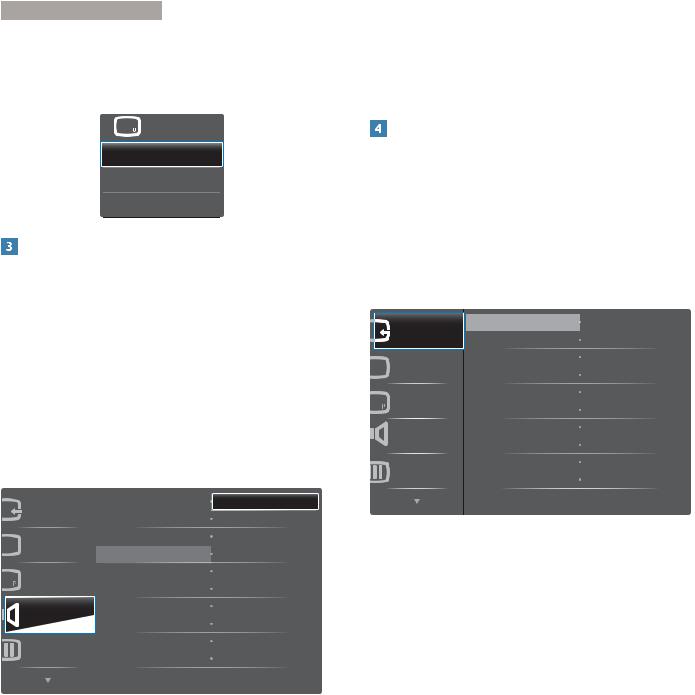
2. Setting up the monitor
6.For example, if you selected
[Audio Source] as the hotkey, press the 
 button on the front bezel, the [Audio Source] menu appears.
button on the front bezel, the [Audio Source] menu appears.
Audio
Audio In
HDMI
DisplayPort
Independent audio playback, regardless of video input
Your Philips monitor can play the audio source independently, regardless of which video input.
1.For example, you can play your MP3 player from the audio source connected to the [Audio In] port of this monitor, and still watch your video source connected from [HDMI], or [DisplayPort].
2.Press  button on the front bezel to enter OSD Menu Screen.
button on the front bezel to enter OSD Menu Screen.
|
|
|
|
|
|
Volume |
|
|
Audio In |
||||
|
|
|
|
|
|
|
|
|
|
|
|||
Input |
|
|
|
||||||||||
|
|
|
|
|
|
|
|
|
|
|
|
||
|
|
|
|
|
|
Stand-Alone |
|||||||
|
|
|
|
|
|
|
HDMI |
||||||
|
|
|
|
|
|
|
|
|
|
|
|||
|
|
|
|
|
Mute |
||||||||
|
|
|
|
|
|
|
DisplayPort |
||||||
|
|
|
|
|
|
||||||||
Picture |
|
Audio Source |
|
|
|
||||||||
|
|
|
|
|
|
|
|
||||||
|
|
|
|
|
|
|
|
|
|
|
|
|
|
PiP/PbP |
|
|
|
||||||||||
Audio
Color
3.= ^ _ [Audio], then press  button.
button.
4.= ^ _ [Audio Source], then press  button.
button.
5.= ^ _ + preferred audio source: [DisplayPort], [HDMI], or [Audio In].
6.Press  +
+
 Note
Note
! The next time you turn on this monitor, it will by default select the audio source you previously selected.
! In case you want to change it, you will have to go through the selection steps again to select your new preferred audio source as the default.
Description of the On Screen Display
What is On-Screen Display (OSD)?
X Z + XZ $ Philips LCD monitors. It allows an end user to adjust screen performance or select functions of the monitors directly through an on-screen instruction window. A user friendly on screen display interface is shown as below:
VGA
Input  DVI
DVI
MHL-HDMI
Picture
DisplayPort
PiP/PbP
Audio
Color
Basic and simple instruction on the control keys
In the OSD shown above, you can press
 buttons at the front bezel of the monitor to move the cursor, and press OK button to
buttons at the front bezel of the monitor to move the cursor, and press OK button to
7
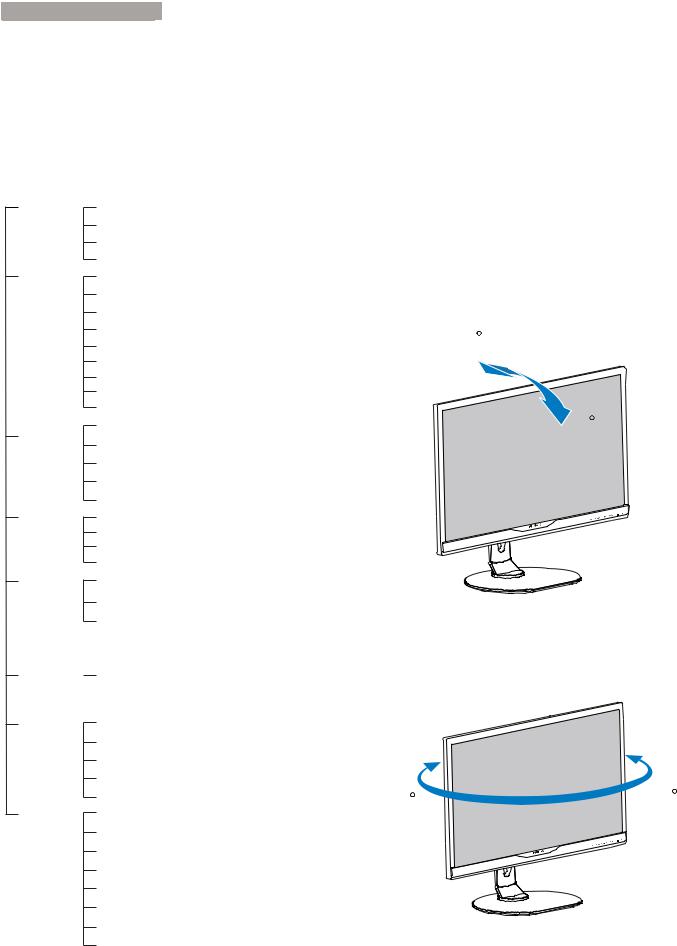
2. Setting up the monitor
The OSD Menu
Below is an overall view of the structure of the On-Screen Display.You can use this as a reference when you want to work your way around the different adjustments later on.
288P6LJ
Main menu |
Sub menu |
Input
Picture
PiP/PbP
Audio
Color
Language
OSD Settings
Setup
VGA |
|
|
|
|
|
DVI |
|
|
|
|
|
MHL-HDMI |
|
|
|
|
|
DisplayPort |
|
|
|
|
|
Picture Format |
|
|
|
|
Wide Screen, 4:3 |
|
|||||
Brightness |
|
0~100 |
|||
|
|||||
Contrast |
|
0~100 |
|||
|
|||||
Black Level |
|
0~100 |
|||
|
|||||
Sharpness |
|
0~100 |
|||
|
|||||
SmartResponse |
|
|
|
|
Off, Fast, Faster, Fastest |
|
|
|
|
||
SmartContrast |
|
|
|
|
Off, On |
|
|
|
|
||
Gamma |
|
1.8, 2.0, 2.2, 2.4, 2.6 |
|||
|
|||||
Over Scan |
|
|
|
|
Off, On |
|
|
|
|
||
PiP/PbP Mode |
|
|
|
|
Off, PiP, PbP |
|
|
||||
PiP/PbP Input |
|
|
|
|
DVI, HDMI, DisplayPort |
|
|
||||
PiP Size |
|
|
|
|
Small, Middle, Large |
|
|
||||
PiP Position |
|
|
|
|
Top-Right, Bottom-Right |
|
|
||||
Swap |
|
|
|
|
|
Volume |
|
0~100 |
|||
|
|||||
Stand-Alone |
|
|
|
|
On, Off |
|
|
|
|
||
Mute |
|
|
|
|
On, Off |
|
|
|
|
||
Audio Source |
|
|
|
|
Audio In , HDMI, DisplayPort |
|
|
|
|
||
Color Temperature |
|
|
|
|
5000K, 6500K, 7500K, |
|
|
|
|
||
sRGB |
|
|
|
|
8200K, 9300K, 11500K |
|
|
|
|
|
|
User Define |
|
|
|
|
Red: 0~100 |
|
|
|
|
||
|
|
|
|
|
Green: 0~100 |
|
|
|
|
|
|
|
|
|
|
|
Blue: 0~100 |
|
|
|
|
|
|
English, Deutsch, Español, Français, Italiano,
Maryar, Nederlands, Português, Português do Brazil, Polski , , Svenska, Suomi, Türkçe, Čeština,
|
-! |
- |
- |
|||
Horizontal |
|
|
|
0~100 |
|
|
|
|
|
|
|||
Vertical |
|
|
|
|
0 ( available for selective model) |
|
|
|
|
||||
Transparency |
|
|
|
|
Off, 1, 2, 3, 4 |
|
|
|
|
||||
OSD Time Out |
|
|
|
|
5s, 10s, 20s, 30s, 60s |
|
|
|
|
||||
User |
|
|
|
|
Audio Source, Volume, Input |
|
|
|
|
||||
Auto |
|
|
|
|
|
|
H.Position |
|
|
|
0~100 |
|
|
|
|
|
||||
V.Position |
|
|
|
0~100 |
|
|
|
|
|
||||
Phase |
|
|
|
0~100 |
|
|
|
|
|
||||
Clock |
|
|
|
0~100 |
|
|
|
|
|
||||
Resolution Notification |
|
|
|
On, Off |
|
|
|
|
|
|
|||
Reset |
|
|
|
|
Yes, No |
|
|
|
|
|
|
||
|
|
|
|
|
|
|
Information

This monitor is designed for optimal performance at its native resolution,
3840 × 2160 @ 60 Hz.When the monitor is powered on at a different resolution, an alert is displayed on screen: Use
3840 × 2160 @ 60 Hz for best results.
Display of the native resolution alert can be switched off from Setup in the OSD X Z +
 Physical Function
Physical Function
Tilt
20
-5
Swivel
-65 |
+65 |
8

2. Setting up the monitor
Height adjustment
 150mm
150mm
Pivot
0
 90
90
2.3 MultiView
What is it?
Multiview enables active dual connect and view so that you can work with multiple devices like PC and Notebook side-by-side simultaneously, making complex multi-tasking work a breeze.
Why do I need it?
With the ultra high resolution Philips MultiView display, you can experience a world of connectivity in a comfortable way in the$ ~ +) + conveniently enjoy multiple content sources at one screen. For example:You may want to keep an eye on the live news video feed with audio in the small window, while working on your
) + + * •€ from your Ultrabook, while logged into secured+ $
9

2. Setting up the monitor
How to enable MultiView by hotkey?
1.Press the hotkey 



 directly on the front bezel.
directly on the front bezel.
2.The MultiView selection menu appears. = ^ _
P Multi View
PiP
PbP
Swap
Off
3.Press + and then exit automatically.
+ and then exit automatically.
How to enable MultiView by OSD menu?
Besides pressing the hotkey


 directly on the front bezel, the MultiView function can also be selected in OSD menu.
directly on the front bezel, the MultiView function can also be selected in OSD menu.
1.Press button on the front bezel to enter OSD Menu Screen.
button on the front bezel to enter OSD Menu Screen.
|
|
PiP/PbP Mode |
Off |
Input |
|
PiP |
|
|
|
PiP/PbP Input |
|
|
|
PiP Size |
PbP |
Picture |
PiP Position |
|
|
|
|
|
|
|
|
Swap |
|
PiP/PbP |
|
||
Audio
Color
! = ^ _ [PiP / PbP], then press button.
button.
! = ^ _ |PiP / PbP Mode], then press button.
button.
! = ^ _ |PiP] or [PbP].
! Now you can move backward to set the [PiP / PbP Input], [PiP Size], [PiP Position]., or [Swap].
2. Press +
+
MultiView in OSD menu
PiP / PbP Mode:There are two modes for MultiView: [PiP] and [PbP].
[PiP]: Picture in Picture |
|
|
|
|
|
|
|
Open up a sub-window of |
|
|
|
|
B |
||
another signal source. |
|
||
A(main) |
|||
|
|||
|
|
|
|
|
|
|
|
When the sub source is not |
|
B |
|
|
detected: |
|
|
||
A(main) |
||||
|
||||
|
|
|
|
|
|
|
|
|
|
[PbP]: Picture by Picture
Open up a sub-window side- |
|
by-side of another signal |
B A(main) |
source. |
When the sub source is not detected:
A(main)
 Note
Note
The black strip shows on the top and the bottom of the screen for the correct aspect ratio when in the PbP mode.
10
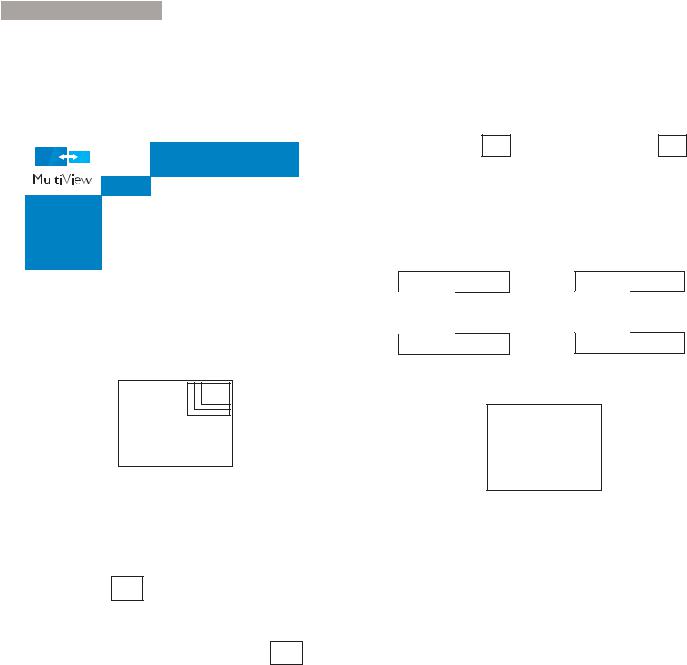
2. Setting up the monitor
PiP / PbP Input:There are four different video input to choose as the sub display source: [DVI], [HDMI], and [DisplayPort].
Please refer below table for compatibility of main/sub input source.
|
|
|
SUB SOURCE |
|
|||
|
|
|
POSSIBILITY (xl) |
|
|||
|
|
Inputs |
VGA |
DP |
DVI |
HDMI |
|
|
|
||||||
MAIN |
VGA |
|
|
|
|
|
|
DP |
|
|
|
|
|
||
SOURCE |
|
|
|||||
DVI |
|
|
|
|
|
||
|
(xl) |
|
|
||||
|
HDMI |
|
|
|
|
|
|
|
|
|
|
||||
PiP Size:When PiP is activated, there are three sub-window sizes to choose: [Small], [Middle], [Large].
SmallB
Middle
Large
A(main)
PiP Position: When PiP is activated, there are two sub-window positions to choose.
Top-Right Bottom-Right
|
|
|
|
|
|
|
|
B |
|
|
A(main) |
||
A(main) |
|
|
||||
|
|
|
|
|
|
|
|
|
|
|
|
B |
|
|
|
|
|
|
|
|
Swap: The main picture source and the sub picture source swapped on the display.
Swap A and B source in [PiP] mode:
|
|
|
|
|
|
|
|
B |
|
|
|
A |
|
A(main) |
|
|
B(main) |
|||
|
|
|
|
|
|
|
Swap A and B source in [PbP] mode:
B A(main) A B(main)
Off: Stop MultiView function.
A(main)
 Note
Note
When you do the SWAP function, the video and its audio source will swap at the same time. (Refer to page 7 “Independent audio playback, regardless of video input” for more
11
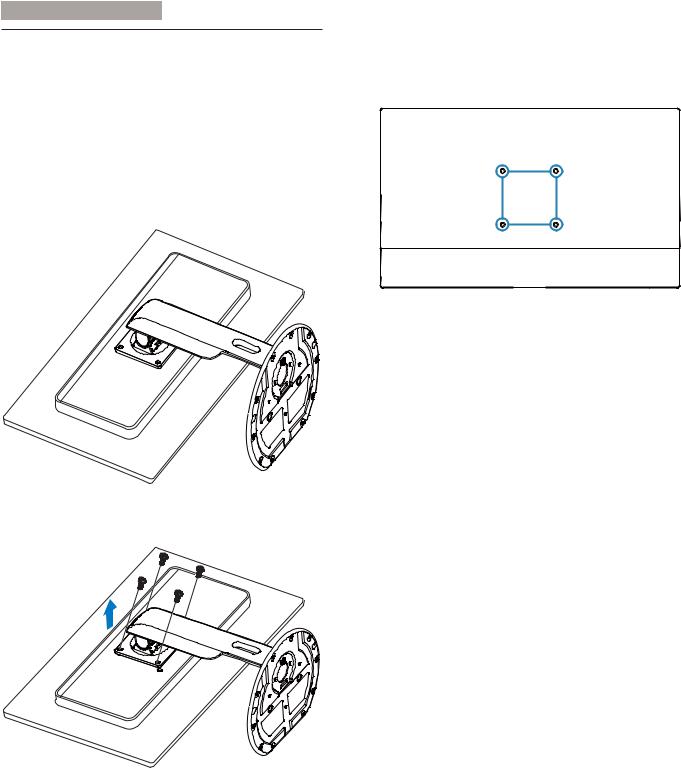
2. Setting up the monitor
2.4Remove the Base Assembly for VESA Mounting
Before you start disassembling the monitor base, please follow the instructions below to avoid any possible damage or injury.
1.Place the monitor face down on a smooth surface. Pay attention not to scratch or damage the screen.
2.Loosen the assembly screws, then detach the neck from the monitor.
 Note
Note
This monitor accepts a 100mm x 100mm VESA-Compliant mounting interface.
100mm
100mm
12
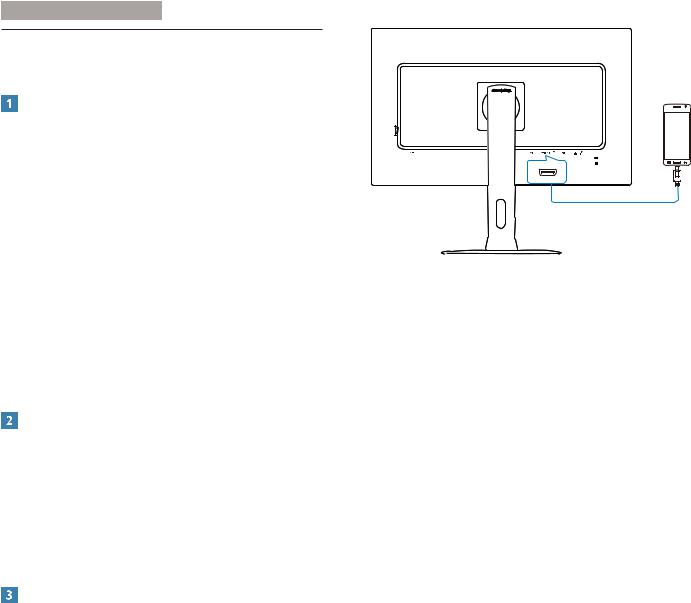
2. Setting up the monitor
2.5 Link)introduction
What is it?
audio/videointerface for directly connecting mobile phones and other portable devices to+
An optional MHL cable allows you to simply connect your MHL capable mobile device to this large Philips MHL display, and watch your HD videos come to life with full digital sound. Now not only you can enjoy your mobile games, photos, movies, or other apps on its big screen, you can simultaneously charge your mobile device so you never run out of power half way.
How do I use the MHL function?
To use the MHL function, you need an MHL- " < • $< ) < $ *]‚‚***
ƒ cable in order to use this function.
How does it work? (how do I connect?)
Connect the Optional MHL cable to the mini USB port on the mobile device side, and the [MHL-HDMI] marked port on the monitor side. You are now ready to view the images on your big screen display and operate all function on + < ) game playing, photo browsing…etc. if your monitor has speaker function, then you will be able to hear accompanying sound too.When the MHL cable is disconnected or the mobile device is turned off, the MHL function will be automatically disabled.
MHL-HDMI
MHL
 Note
Note
! The port marked [MHL-HDMI] is the only port on the monitor that supports the MHL function when the MHL cable is used. Note that the MHL certified cable is different than a standard HDMI cable.
! A mobile device with MHL certification must be purchased separately
! You may have to manually switch the monitor to MHL-HDMI mode in order to activate the monitor, if you have other devices already working and connected to available inputs
! Standby/Off energy saving of ErP is not applicable for the MHL charging functionality
! This Philips display is MHL certified. However, in case your MHL device does not connect or work correctly, check with your MHL device FAQ or vendor directly for direction.The policy of your device manufacturer may require you to purchase their brand specific MHL cable or adapter in order to work with other brand MHL devices. Note that this is not a fault of this Philips display.
13
